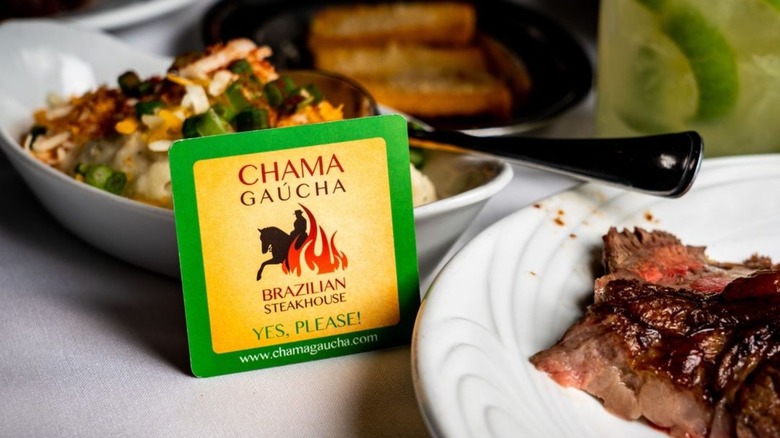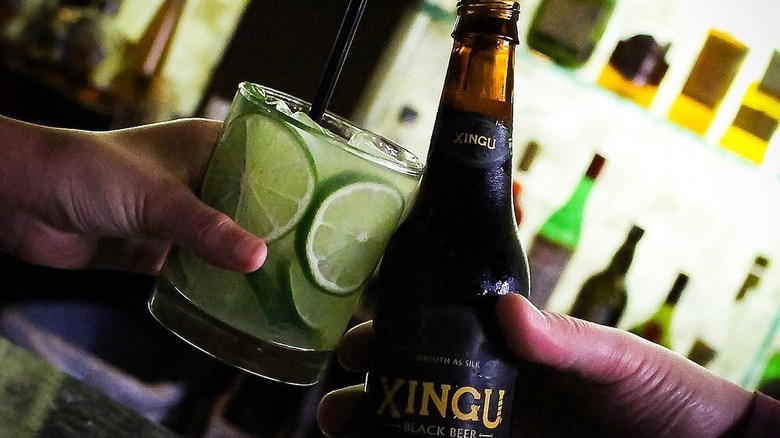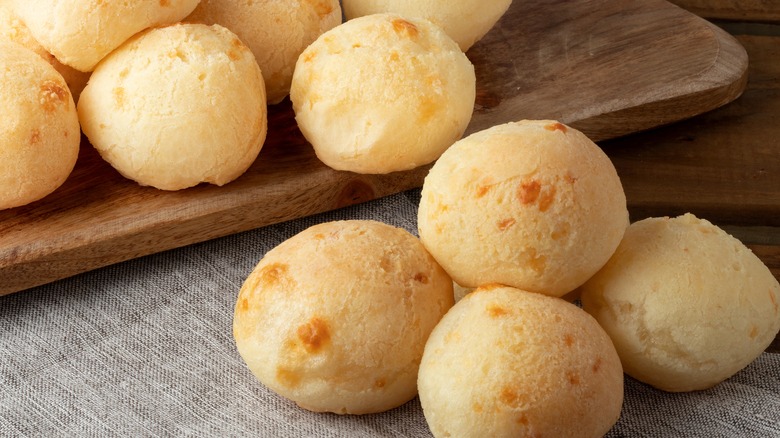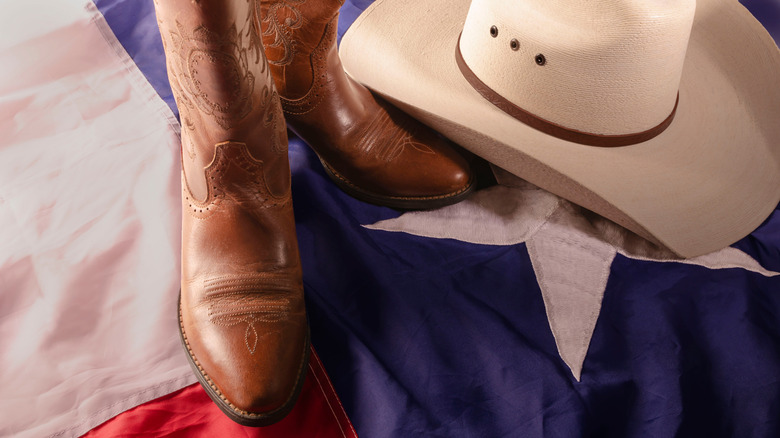The Untold Truth Of Chama Gaucha Brazilian Steakhouse
Is there anything more brazenly carnivorous than eating fire-roasted meat off a sword? Brazilian steakhouses, also known as churrascarias, are famous for their generous offerings of barbecued meats often served in just such a manner, prepared by specially-trained gaucho chefs. Renowned for their extraordinary hospitality and all-you-can-eat options, Brazilian steakhouses are sweeping across America to great acclaim. One of the rising stars in the world of churrascarias is Chama Gaúcha, first opened in 2008 by João Carlos Ongaratto in San Antonio, Texas (via Chama Gaúcha).
With a mission to recreate the cultural traditions and camaraderie that are fundamental to the churrascaria scene in Southern Brazil, Chama Gaúcha is winning over the hearts and bellies of diners through its passionate dedication. Even though Chama Gaúcha has made a big splash at its three current locations, you may not be aware of the finer details surrounding the restaurant. You also might be surprised by the restaurant's background and some of its lesser-known propensities and menu items. Here's the untold truth of Chama Gaúcha Brazilian Steakhouse.
Its name means flame of the gaucho
Chama Gaúcha is a clever name that works on multiple levels. According to San Antonio Eats, chama translates to "flame" from Portuguese, the language of Brazil. In a strictly literal sense, of course, this conjures up the image of a flame, a nod to how Brazilian barbecue is typically cooked over an open fire. But the meaning of the flame goes even further beyond that, alluding to the spirit and cultural heart of the gauchos.
The word gaucho refers to the cattle-herding cowboys of South America (via Britannica). Using a lasso and a knife, gauchos roamed the countryside and rounded up cattle to gather meat for communal barbecues. Aside from hunting and cooking, gauchos became legendary for their love of the high life, including culinary delights like drinking and preparing delicious rustic meals. The spirit of the gaucho has been passed down for generations. Today, the word is often used in concert with the specially-trained chefs in Brazilian steakhouses who cook and serve all of those succulent fire-roasted meats that churrascarias are well-known for (via Fogo de Chão).
It has a special signature drink
Most places across the globe have drinks that are unique to their specific region and that's certainly true for Brazil. Brazil's national cocktail is the caipirinha, a mix of lime juice, sugar, and a spirit made from fermented sugarcane juice called cachaça (via Liquor.com). You might be tempted to compare Brazil's national cocktail to a margarita, but that doesn't do the caipirinha proper justice. Others liken cachaça to rum, but that isn't entirely accurate either — both cachaça and rum are made from sugar, but rum is made from sugarcane byproducts such as molasses, while cachaça is made straight from sugarcane. This slight deviation tends to make rum sweeter than cachaça and gives cachaça an earthier and more herbaceous flavor profile (via Smithsonian Magazine).
As a testament to its Brazilian roots, Chama Gaúcha selected the caipirinha as its signature drink. Chama Gaúcha's caipirinha is made with fresh lime juice, sugar, and two ounces of Velho Barreiro cachaça (via Chama Gaúcha). If you're looking for something special with a tropical, fruity twist, Chama Gaúcha also offers some flavored caipirinhas such as strawberry, pineapple, passionfruit, and tropical.
The owner sharpened his skills at Fogo de Chão
Who better to open up a new Brazilian steakhouse than someone who truly understands the culture and business model inherent in the concept? After working at churrascaria Fogo de Chão for over two decades, native Brazilian João Carlos Ongaratto opened the doors to the first Chama Gaúcha in 2008. What sets Chama Gaúcha apart from Fogo de Chão? For one, it's the feel of the place. Chama Gaúcha puts a lot of emphasis on carefully creating an exceptionally warm and inviting atmosphere, stating on the restaurant's website that "each customer comes in a guest and leaves feeling just like family" (via Chama Gaúcha).
Since its first location opened in San Antonio, Chama Gaúcha has gone on to establish two more restaurants in Houston and Chicago. Clearly, by honing his craft in the Brazilian steakhouse business for over 20 years, João Carlos Ongaratto was not only honoring the rich traditions and culture of his homeland but also paving the way for a future business plan of his own.
Its salad bar is well known
Brazilian steakhouses are well-known not just for their generous portions of flame-broiled meats, but also for what often turns out to be their enormous and delicious salad bars. Chama Gaúcha boasts a high-quality salad bar with a wide array of different items, making it a highly desired culinary destination for meat lovers and vegetarians alike. But what kind of offerings does the salad bar at Chama Gaúcha have?
A peek into the restaurant's Instagram page indicates that some of the diverse salad bar items at Chama Gaúcha include specialty cheeses, cured meats, fresh vegetables, olives, asparagus, peppers, and more. All told, the salad bars at Chama Gaúcha's locations are downright lush. That's pretty impressive, especially given how well steakhouses are known for, you know, the steaks. Even vegetarians will find plenty to eat at what's traditionally a thoroughly carnivorous sort of place.
Chama Gaúcha's marinades are gluten-free
Chama Gaúcha has good news for those of you with a gluten-free diet: all of its marinades are now gluten-free. According to Gluten-Free Go-To Guide, Chama Gaúcha used to add beer (which typically contains gluten) to some of its marinades. It has since removed any gluten-containing ingredients specifically to accommodate a wider range of diners.
Beer has often been a popular additive to marinades because it has a way of deliciously tenderizing meat and adding unique richness to any dish it touches. Yet, it can be a real problem for those with gluten allergies.
According to Everyday Health, gluten is a protein found in wheat, barley, and rye — some of the key ingredients in alcohol production overall, as especially when it comes to brewing beer. For people who are sensitive to gluten, ingesting these ingredients can trigger an autoimmune response that damages the small intestine, leading to a wide range of health complications. Chama Gaúcha's decision to forgo gluten in its marinades is an important one for any diners with celiac disease or gluten sensitivities. While we can't be sure of what the secret ingredients are for Chama Gaúcha's new marinade recipe, rest assured it's equally delicious and safe for a wide variety of diners to consume.
It offers 12 different meats
Brazilian steakhouses are rightfully famous for their glorious abundance of flame-charred meats. In the true form to a traditional churrascaria, Chama Gaúcha follows suit and honors this custom by offering 12 cuts of meat at its restaurants (via Chama Gaúcha). Naturally, many of those options are focused on the historic favorite of the gauchos: beef.
Picanha, a prime cut of sirloin, is Chama Gaúcha's house specialty. Other beef offerings include fraldinha (bottom sirloin), ribeye, and filet mignon. When it comes to pork, Chama Gaúcha offers porco — which takes the form of a rack of pork ribs or loins lightly seasoned with parmesan. If ribs are your jam, there's also the cordeiro (that would be lamb). Bacon lovers will be delighted by the filet mignon e frango — a filet of beef or chicken wrapped in cured pork belly. And then there's the pairing called frango e linguica, which is made of marinated drumsticks and pork sausage. Ultimately, by offering at least a dozen different barbecued meats, Chama Gaúcha is ensuring that diners have plenty of distinctively delicious options.
Chama Gaúcha ages its meats for 45 days
As a restaurant in the business of flame-grilling different cuts of meats, Chama Gaúcha understands the importance of maximizing the flavor of its barbecue. This dedication to flavor becomes apparent upon learning that Chama Gaúcha not only uses only high-quality USDA Prime meats but that it ages the cuts for a minimum of 45 days before seasoning them to perfection (via The Colorful Chronicle).
Aging is a surefire way to enhance all of the flavors of the meat and the sweet spot seems to be somewhere in the range of 30 to 45 days (via The Aging Room). This is because aging slowly draws some of the interior moisture out of the meat, a process that ends up dramatically concentrating the meat's natural flavor profile. Beyond this, the aging process breaks down the meat's natural enzymes and tenderizes the meat to create a juicier and more delicate bite when the cut finally makes it to your plate.
By aging all of its meats (and using the good stuff, to begin with) there's no doubt that Chama Gaúcha is pleasing its diners by improving the flavor of its Brazilian barbecue beyond an already impressive baseline.
It has an impressive happy hour
Having a solid happy hour is obviously a great way to bring customers in and keep them coming back. Judging by the incredible happy hour specials that it runs throughout the week, Chama Gaúcha deeply understands this. According to The Happy Hours, Chama Gaúcha offers a well-stocked selection of beverages and special small plates at its restaurants for most of the week. If you're looking to beat back that early workweek blues, happy hour lasts all day on Mondays and Tuesdays at Chama Gaúcha. After that, happy hour starts up after lunch and ends before dinner on Wednesdays, Thursdays, and Fridays.
Wondering what the Chama Gaúcha's happy hour menu looks like? Allow us to enlighten you. According to the restaurant, you can score its signature drink, an authentic caipirinha, for only seven bucks and most of its beers will only set you back a few dollars. Mixed drinks are anywhere from six to eight bucks and it even has a couple of different glasses of wine for variety's sake.
Aside from the booze, Chama Gaúcha also offers a few light plates of food for you to nibble on during happy hour. These include otherwise pricey filet mignon, grilled shrimp, garlic beef, and house signature picanha. You could easily pull off a drink and a bite that'll end up costing you around $20 — a great deal for such a high-quality meal.
Chama Gaúcha has earned serious accolades
Surely, every restaurant wants to earn the respect of the community as one of the best in the business. Broadly speaking, such a spotlight can help bring in more customers and also send a message to the restaurant staff that their contribution to the food scene is being noticed and appreciated. Impressively, for a relatively small operation with just three locations, Chama Gaúcha has pulled off just such an accomplishment.
Urban Matter selected Chama Gaúcha as one of the best Brazilian restaurants in the Chicago area, an extraordinary feat in a city that's renowned for its vibrant food culture with no shortage of churrascarias. Why did Chama Gaúcha rise above the rest? For one, it gained attention because of its stellar ingredients and excellent service — two key features any self-respecting diner looks for in a top-notch restaurant. More accolades have come from the San Antonio Current, where Chama Gaúcha came in the first place amongst steakhouses and was listed as the best restaurant of its kind in San Antonio in 2021 — for the third year running, no less. With distinctions like these, it's clear that Chama Gaúcha is here to stay.
The meal starts with delicious pão de queijo
Your meal at the Chama Gaúcha Brazilian steakhouse will start with delicious Brazilian cheese balls called pão de queijo (cheese bread). If you haven't tried them before, you're in for a treat. Most pão de queijo is made with simple ingredients like eggs, oil, milk, cheese, and tapioca flour (via Mashed). The flavor of these puffed cheese bites is similar to cheese straws, and some people describe the texture inside as being close to mochi (via Houston Press).
The interesting texture of pão de queijo comes from tapioca flour. Tapioca flour is a typical ingredient in Brazilian cooking, coming from the cassava tuber root. If you have wheat or gluten sensitivities, you'll be happy to learn that, even though tapioca has lots of carbs, it's gluten-free. There aren't many cases of people experiencing allergic reactions to cassava (via Healthline). So, as long as you're not allergic to any of the other ingredients, you should find pão de queijo safe to eat.
If you don't like a cut, tell them you're hungry, and they'll bring you a new one
When you visit the Chama Gaúcha Brazilian steakhouse you can expect an all-you-can-eat dining experience. Every time you want a server to return to your table with more meat, all you have to do is flip your card over from the red to the green side to indicate that you're still hungry. Customers report that you can even ask for new meat if you already have some on your plate that wasn't to your liking (via Reddit). The good news is that you're likely to get a cut of meat you like the first time since the servers will ask how well you want your meat done (via Reddit).
With 12 different types of meat available, it may be tempting to try them all (via Chama Gaúcha). Eva M. Krockow, who has a doctorate in psychology, says that we're more likely to overeat when we're offered delicious food in an all-you-can-eat format, especially when the food has a high price tag. After all, we want to get our money's worth. She suggests that it's easiest to avoid overeating when you're no longer hungry if you separate the price of the meal from the food in your mind (via Psychology Today). It might help if you think about the fact that you're paying for a Brazilian steakhouse experience as much as you are paying for the food.
Most of Chama Gaúcha's restaurants are in Texas
The Chama Gaúcha Brazilian steakhouse currently has three restaurants with a fourth one in the works. While one is in the Chicago suburbs, all the others are in Texas. After all, the chain's headquarters are in Texas (via LinkedIn).
When most people think of Texas, they think of cowboys and cattle wrangling. It was in southern Brazil among the gaucho (cowboy) culture where the concept of the Brazilian steakhouse was born (via Eater). So, it's no surprise that Brazilian steakhouses thrive in a similar cowboy culture that is enamored with beef (via Texas Standard).
Everything is bigger in Texas, and this is especially true when it comes to the newest Chama Gaúcha restaurant opening in Dallas. The site of the latest Chama Gaúcha was once home to another Brazilian steakhouse called Boi Na Braza, and the building is a whopping 1.1 million square feet (via What Now DFW). According to city documents, the renovated dining space is big enough to accommodate 389 customers, and the parking lot has space for 160 vehicles (via Community Impact).
You'll get better service during off-peak hours
Chama Gaúcha's servers have a tendency to be obsessively attentive to their customers. When they're not overly busy, it's not uncommon to have more than one server descend upon you the moment you switch your table's card from red to green, displaying a variety of mouth-watering meats. A review of the restaurant in Houston Press found this attention to keeping water glasses full almost become annoying, especially if intimate conversations were interrupted. However, during peak hours, the number of customers in the restaurant can cause the service and atmosphere to suffer (via Reddit). And, with more customers to help, it's impossible for them to serve every customer as quickly as at slower times.
The best time to visit the Houston Chama Gaúcha is at lunch and before 7 pm Monday through Friday. Visit before 5 pm on Saturdays and before 6 pm on Sundays. (via Google). For the best service, visit the San Antonio Chama Gaúcha at lunch, Monday through Tuesday before 7 pm, or Wednesday through Friday before 6 pm. Saturday diners will get the best service before 4 pm. And Sunday has two peaks between 2 pm and 3 pm and again from 6 pm to 8 pm (via Google).
The Chicago restaurant in the Downers Grove suburb isn't open for lunch. However, they aren't very busy at all from Monday through Thursday, so those are the best days to visit. Business picks up on the weekend, so it's best to visit on Fridays and Saturdays before 7 pm and Sundays before 4 pm (via Google).













